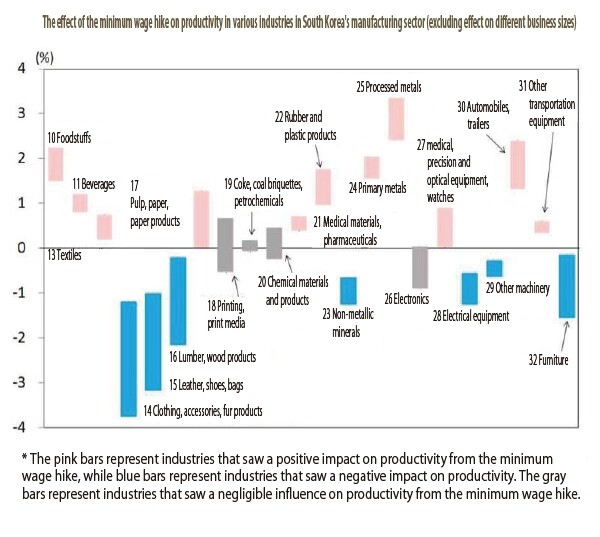hankyoreh
Links to other country sites 다른 나라 사이트 링크
BOK studies say minimum wage hike has increased productivity but decreased job growth

South Korea’s minimum wage hike has had a positive effect on productivity in the domestic manufacturing sector and a somewhat negative effect on employment, according to a pair of recent studies by the Bank of Korea (BOK).
“The minimum wage hike is assumed to have had a positive effect on overall productivity in the manufacturing sector,” wrote Kim Gyu-il, a professor at Michigan State University, and Yuk Seung-hwan, a researcher at the BOK’s Economic Research Institute, in a Dec. 13 report titled “The Minimum Wage and Productivity: Cases Studies from South Korea’s Manufacturing Industry.”
The researchers used employment surveys for each region and Statistics Korea’s economically active population surveys from 2011 to 2016 to calculate the percentage of workers receiving the minimum wage and to determine the “minimum wage impact ratio,” which means the percentage of workers who receive up to 120% of the minimum wage.
The researchers found that the minimum wage impact ratio varied significantly depending on the business type and company size. “By business type, the minimum wage impact ratio was above 20% in foodstuffs and attire and below 5% in petroleum refining and various types of shipping. By company size, the ratio was above 30% in small companies (fewer than five employees) and below 5% in large companies (more than 300 employees),” the report said.
This study found that the minimum wage hike had generally had a positive impact on productivity in the manufacturing sector by changing the minimum wage impact ratio. The business types that enjoyed a major positive impact included automobiles, foodstuffs, primary metals and textile products, while there were also some business types that were negatively affected, including electronic products and non-ferrous metals. The study also found that the positive impact on productivity was proportional to scale.
A paper on a related topic, titled “The Minimum Wage’s Effect on the Employment Structure,” was released on Friday. This paper was written by Son Heon-jae, a professor at the University of Seoul; Shin Woo-ri, a doctoral student at the University of Seoul; and Lim Hyeon-jun, a researcher at the Bank of Korea’s Economic Research Institute.
If the minimum wage hike leads to a one point increase in the percentage of workers who are currently making less than the higher minimum wage that will take effect next year, the paper found, the ratio of irregular workers to regular workers will rise by 0.68 points and the gap in monthly wages between regular and irregular workers will increase by about 5,000 won.
“Considering that the percentage of people receiving less than the current minimum wage and the percentage of people receiving less than the new minimum wage fluctuated between 4 and 8% and 6 and 12%, respectively, in the period being reviewed, a one point increase is presumed to be a substantial degree of change. But since the average ratio of irregular to regular workers during this period was 45.14%, a 0.45 or 0.68 increase is not regarded as a major change,” the report said.
By Lee Soon-hyuk, staff reporter
Please direct comments or questions to [english@hani.co.kr]

Editorial・opinion
![[Column] A rift in Korea’s ruling camp, made wider by its first lady [Column] A rift in Korea’s ruling camp, made wider by its first lady](https://flexible.img.hani.co.kr/flexible/normal/500/300/imgdb/original/2024/0708/9317204261622813.jpg) [Column] A rift in Korea’s ruling camp, made wider by its first lady
[Column] A rift in Korea’s ruling camp, made wider by its first lady![[Column] Korea and the return of Trump [Column] Korea and the return of Trump](https://flexible.img.hani.co.kr/flexible/normal/500/300/imgdb/original/2024/0708/9217204252680575.jpg) [Column] Korea and the return of Trump
[Column] Korea and the return of Trump- [Column] Is Korean democracy really regressing?
- [Column] How tragedy pervades weak links in Korean labor
- [Column] How opposing war became a far-right policy
- [Editorial] Korea needs to adjust diplomatic course in preparation for a Trump comeback
- [Editorial] Silence won’t save Yoon
- [Column] The miscalculations that started the Korean War mustn’t be repeated
- [Correspondent’s column] China-Europe relations tested once more by EV war
- [Correspondent’s column] Who really created the new ‘axis of evil’?
Most viewed articles
- 1[Column] Is Korean democracy really regressing?
- 2Over 200,000 Koreans sign petition calling for deportation of Yemeni refugees in Jeju
- 3Real-life heroes of “A Taxi Driver” pass away without having reunited
- 4Former bodyguard’s dark tale of marriage to Samsung royalty
- 5Health care experts call on government to address problems with end of life legislation
- 610 days of torture: Korean mental patient’s restraints only removed after death
- 7What will a super-weak yen mean for the Korean economy?
- 8Shoddy records help Korean hospitals conceal abuse of mentally ill
- 9Koreans are getting taller, but half of Korean men are now considered obese
- 10BBC documentary’s new revelations about Burning Sun scandal reignite rage, grief in Korea